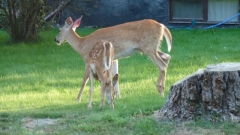Annual count shows Grand Forks deer numbers stabilizing
This week’s annual deer count showed a stable but declining population.
The count on Tuesday, Sept. 18 came up with 154 deer living within the Grand Forks city limits. That is down from last year’s 179.
“We’re seeing the deer level out — they seem to have peaked,” said Cher Wyers, Grand Forks councillor while chairing the Grand Forks Environment Committee, Thursday, Sept. 20.
Wyers participated in the count in the downtown area and was amazed at the height and quantity of deer fencing lining every back alley.
“I find it disturbing and everyone is building huge fences,” Michele Caskey, a member of the committee, said during the meeting.
My street is looking like a fortress. What are we supposed to do — build a moat around Grand Forks?
Caskey, a passionate gardener, finds it frustrating to have to fight them off her plants all summer long. She’s lived in Grand Forks for years and recalls a time when deer didn’t roam city streets as they do today.
She blames the situation on people feeding them.
Jenny Coleshill would agree. Coleshill, also a member of the committee in addition to being the project coordinator for the Granby Wilderness Society, said the first white tail deer didn’t appear in Grand Forks area until the 1930s. White tail deer are considered an “edge species” and thrive living close to humans, who feed them.
“Deer feeding is a big issue,” she said, suggesting that during the next count it might be interesting to map out where they find the deer and see if the highest concentrations are in areas where known deer feeders live.
As for ways of dealing with them, culling is still on the list, as is relocation.
Coleshill, a biologist, said relocating urbanized deer is not a feasible solution.
They are town deer and sticking them into the wild is like making them into sitting ducks (for predators).
Culling of the deer is still an option the deer committee will be discussing next week.
Grand Forks city councillor Gary Smith said a cull would be more humane than what is currently controlling the population — vehicle collisions.
“Trauma and damage — it is carnage really,” he said, pointing out that Grand Forks residents pay high insurance rates on their vehicles because there are so many accidents caused by deer.
In an earlier interview, Grand Forks RCMP staff sergeant Jim Harrison said during the summer police are called out three or four times a week to put down deer that have been fatally injured in a vehicle accident.






















